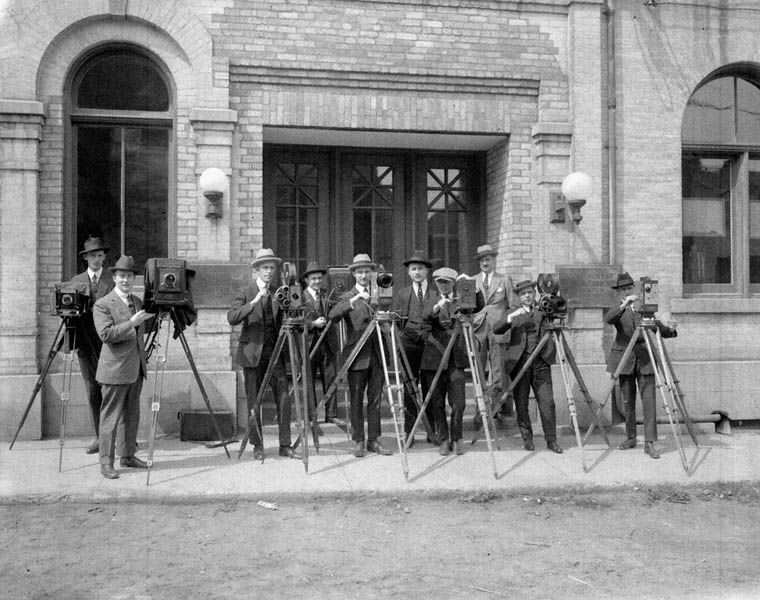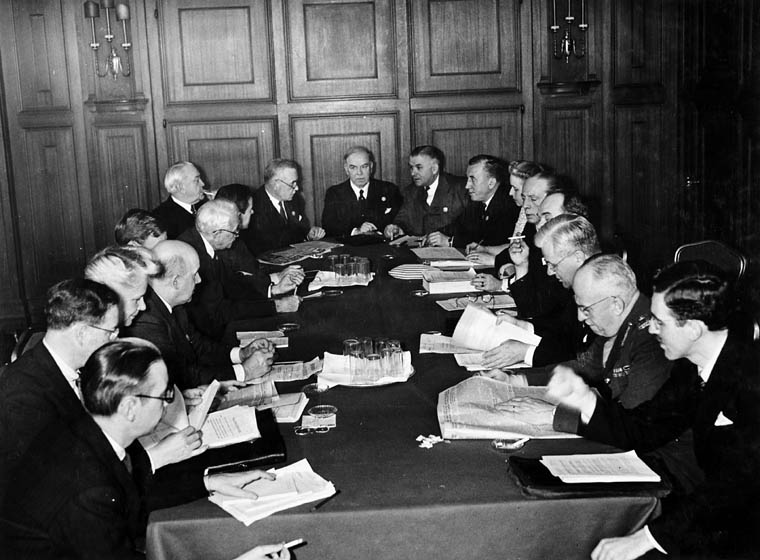Browse "Politics & Law"
-
Article
Canadian Democracy and Corporate Accountability Commission
Created in 2000, the privately funded Canadian Democracy and Corporate Accountability Commission (CDCAC) was co-chaired by Canadian publisher Avie Bennett and ex-NDP leader Ed Broadbent.
"https://development.thecanadianencyclopedia.ca/images/tce_placeholder.jpg?v=e9dca980c9bdb3aa11e832e7ea94f5d9" // resources/views/front/categories/view.blade.php
https://development.thecanadianencyclopedia.ca/images/tce_placeholder.jpg?v=e9dca980c9bdb3aa11e832e7ea94f5d9
-
Article
Canadian Federation of Labour
The Canadian Federation of Labour (National Trades and Labor Congress until 1908) was founded in 1902 as a solely Canadian body dedicated to national organization.
"https://d2ttikhf7xbzbs.cloudfront.net/media/media/deaaaf0f-2d04-4ae8-8391-d6255fe2a78a.jpg" // resources/views/front/categories/view.blade.php
https://d2ttikhf7xbzbs.cloudfront.net/media/media/deaaaf0f-2d04-4ae8-8391-d6255fe2a78a.jpg
-
Article
Canadian Film History: 1939 to 1973
Filmmaking is a powerful form of cultural and artistic expression, as well as a highly profitable commercial enterprise. From a practical standpoint, filmmaking is a business involving large sums of money and a complex division of labour. This labour is involved, roughly speaking, in three sectors: production, distribution and exhibition. The history of the Canadian film industry has been one of sporadic achievement accomplished in isolation against great odds. Canadian cinema has existed within an environment where access to capital for production, to the marketplace for distribution and to theatres for exhibition has been extremely difficult. The Canadian film industry, particularly in English Canada, has struggled against the Hollywood entertainment monopoly for the attention of an audience that remains largely indifferent toward the domestic industry. The major distribution and exhibition outlets in Canada have been owned and controlled by foreign interests. The lack of domestic production throughout much of the industry’s history can only be understood against this economic backdrop. This article is one of four that surveys the history of the film industry in Canada. The entire series includes: Canadian Film History: 1896 to 1938; Canadian Film History: 1939 to 1973; Canadian Film History: 1974 to Present; Canadian Film History: Regional Cinema and Auteurs, 1980 to Present.
"https://d2ttikhf7xbzbs.cloudfront.net/media/media/365bfdc3-53d4-4033-b13f-5a89a83a85d5.jpg" // resources/views/front/categories/view.blade.php
https://d2ttikhf7xbzbs.cloudfront.net/media/media/365bfdc3-53d4-4033-b13f-5a89a83a85d5.jpg
-
Article
Canadian Free Trade Agreement
The Canadian Free Trade Agreement (CFTA) is an inter-governmental trade agreement regulating trade within Canada. It took effect on 1 July 2017. The goal of the agreement was to reduce or eliminate regulations against the free movement of goods, services, and investments within Canada. The officials who framed the new deal said they wanted to ensure that Canadian firms got the same access to the Canadian market as firms from the country’s international trading partners. CFTA also more closely matches the terms of the Canada-European Union Comprehensive Economic Trade Agreement (CETA), which began taking effect in 2017.
"https://d2ttikhf7xbzbs.cloudfront.net/media/media/133a2d02-51cc-4318-b7c7-5aeb80b30cf3.png" // resources/views/front/categories/view.blade.php
https://d2ttikhf7xbzbs.cloudfront.net/media/media/133a2d02-51cc-4318-b7c7-5aeb80b30cf3.png
-
Article
Canadian General Standards Board
The Canadian General Standards Board (CGSB) was established in 1934 under the National Research Council Act as the Government Purchasing Standards Committee and its present name was adopted in 1980.
"https://development.thecanadianencyclopedia.ca/images/tce_placeholder.jpg?v=e9dca980c9bdb3aa11e832e7ea94f5d9" // resources/views/front/categories/view.blade.php
https://development.thecanadianencyclopedia.ca/images/tce_placeholder.jpg?v=e9dca980c9bdb3aa11e832e7ea94f5d9
-
Article
Canadian Government Motion Picture Bureau
The Canadian Government Motion Picture Bureau, founded as the Exhibits and Publicity Bureau in 1918, was the first national film production unit in the world. Its purpose was to produce films that promoted Canadian trade and industry. As the minister of Trade and Commerce put it in 1924, the Bureau “was established for the purpose of advertising abroad Canada’s scenic attractions, agricultural resources and industrial development.” However, the Bureau failed to keep up with technology and was severely hampered by financial difficulties during the Depression. It was absorbed into the National Film Board (NFB) in 1941.
"https://d2ttikhf7xbzbs.cloudfront.net/media/media/663f9a76-c379-498c-8a6d-c80691771897.jpg" // resources/views/front/categories/view.blade.php
https://d2ttikhf7xbzbs.cloudfront.net/media/media/663f9a76-c379-498c-8a6d-c80691771897.jpg
-
Macleans
Canadian Help for East Timor
In the basketball arena in Kupang, West Timor, the young boy was all kitted out in his L.A. Lakers jersey and shorts. A refugee, he looked about 12 years old, one of the thousands of victims of two weeks of violence in East Timor.This article was originally published in Maclean's Magazine on September 27, 1999
"https://development.thecanadianencyclopedia.ca/images/tce_placeholder.jpg?v=e9dca980c9bdb3aa11e832e7ea94f5d9" // resources/views/front/categories/view.blade.php
https://development.thecanadianencyclopedia.ca/images/tce_placeholder.jpg?v=e9dca980c9bdb3aa11e832e7ea94f5d9
-
Article
Canadian Human Rights Act
The Canadian Human Rights Act, created in 1977, is designed to ensure equality of opportunity. It prohibits discrimination on the basis of race, age, sex and a variety of other categories. The Act produced two human rights bodies: the Canadian Human Rights Commission and, through a 1985 amendment, the Human Rights Tribunal Panel (it became the Canadian Human Rights Tribunal in 1998). Decisions of both the Commission and the Tribunal can be appealed to the Federal Court of Canada. Unlike the Charter of Rights and Freedoms, which provides Canadians with a broad range of rights, the Canadian Human Rights Act covers only equality rights. It also governs only federal jurisdictions. Each province and territory in Canada has its own human rights legislation, which apply to local entities such as schools and hospitals.
"https://d2ttikhf7xbzbs.cloudfront.net/media/media/11551bec-a5f6-4e78-b101-265ddf7610cb.jpg" // resources/views/front/categories/view.blade.php
https://d2ttikhf7xbzbs.cloudfront.net/media/media/11551bec-a5f6-4e78-b101-265ddf7610cb.jpg
-
Article
Canadian Human Rights Commission
The Canadian Human Rights Commission and the Human Rights Tribunal Panel were established under the 1977 Canadian Human Rights Act to investigate and resolve individual complaints about discriminatory employment practices.
"https://development.thecanadianencyclopedia.ca/images/tce_placeholder.jpg?v=e9dca980c9bdb3aa11e832e7ea94f5d9" // resources/views/front/categories/view.blade.php
https://development.thecanadianencyclopedia.ca/images/tce_placeholder.jpg?v=e9dca980c9bdb3aa11e832e7ea94f5d9
-
Article
Canadian Identity
The question of what it means to be a Canadian has been a difficult and much debated one. Some people see the question itself as central to that identity. Canadians have never reached a consensus on a single, unified conception of the country. Most notions of Canadian identity have shifted between the ideas of unity and plurality. They have emphasized either a vision of “one” Canada or a nation of “many” Canadas. A more recent view of Canadian identity sees it as marked by a combination of both unity and plurality. The pluralist approach sees compromise as the best response to the tensions — national, regional, ethnic, religious and political — that make up Canada.
"https://d2ttikhf7xbzbs.cloudfront.net/media/media/af24ecdf-07e4-4430-bbe0-b4a913834b9d.jpg" // resources/views/front/categories/view.blade.php
https://d2ttikhf7xbzbs.cloudfront.net/media/media/af24ecdf-07e4-4430-bbe0-b4a913834b9d.jpg
-
Article
Canadian Identity and Language
Language policy in Canada, as it relates to Canadian identity, traditionally encompasses three points of view. One favours an officially bilingual Canada. It reaffirms the country as the product of two “founding peoples.” A version of this approach, introduced by Prime Minister Pierre Trudeau, endorses official bilingualism but rejects the claim that two “peoples” or “nations” deserve any special recognition. Rather, it argues that we should instead emphasize Canada’s multiculturalism. The second position argues that, since no linguistic group deserves special status, the country should therefore have no official languages. The third position argues that Canada is not only multicultural, but also multinational. It argues that French and English should have official status because this recognizes two of the country’s founding nations. This approach also suggests that efforts should be made to help preserve Indigenous languages.
"https://development.thecanadianencyclopedia.ca/images/tce_placeholder.jpg?v=e9dca980c9bdb3aa11e832e7ea94f5d9" // resources/views/front/categories/view.blade.php
https://development.thecanadianencyclopedia.ca/images/tce_placeholder.jpg?v=e9dca980c9bdb3aa11e832e7ea94f5d9
-
Article
Canadian International Council
The Canadian International Council is a public policy think tank dedicated to the discussion and analysis of Canada’s international affairs. It was founded as the Canadian Institute of International Affairs (CIIA) in 1928 by Sir Robert Borden, Sir Arthur Currie, John W. Dafoe and Sir Joseph Flavelle. The organization investigates the important and relevant issues of the day. It seeks to present a diversity of opinions on subjects such as Canada's participation in conflict, relations with the United States, and responsible citizenship in a global community.
"https://d2ttikhf7xbzbs.cloudfront.net/media/media/d5fc44b8-9887-461e-a0e8-2b7bca224420.jpg" // resources/views/front/categories/view.blade.php
https://d2ttikhf7xbzbs.cloudfront.net/media/media/d5fc44b8-9887-461e-a0e8-2b7bca224420.jpg
-
Article
Canadian Institutes of Health Research
Canadian Institutes of Health Research (CIHR) is the major federal agency responsible for funding health research in Canada.
"https://development.thecanadianencyclopedia.ca/images/tce_placeholder.jpg?v=e9dca980c9bdb3aa11e832e7ea94f5d9" // resources/views/front/categories/view.blade.php
https://development.thecanadianencyclopedia.ca/images/tce_placeholder.jpg?v=e9dca980c9bdb3aa11e832e7ea94f5d9
-
Article
Canadian International Development Agency
The Canadian International Development Agency (CIDA) was the federal government agency responsible for administering most of Canada's official co-operation program with developing countries and countries in transition. Formed in 1968, it became part of the Department of Foreign Affairs, Trade and Development in 2013 (now Global Affairs Canada).
"https://development.thecanadianencyclopedia.ca/images/tce_placeholder.jpg?v=e9dca980c9bdb3aa11e832e7ea94f5d9" // resources/views/front/categories/view.blade.php
https://development.thecanadianencyclopedia.ca/images/tce_placeholder.jpg?v=e9dca980c9bdb3aa11e832e7ea94f5d9
-
Article
Canadian Intervention in the Russian Civil War
The Allies accordingly undertook to support anticommunist White Russian forces if they would, once back in power, resume war on the Eastern Front against Germany and Austria, a strategy warmly supported by those in London and Paris, in any case, to see the eradication of Bolshevism from Russia.
"https://d2ttikhf7xbzbs.cloudfront.net/media/media/1cbd0c0f-04ae-42a7-ab4d-16f63b46e397.jpg" // resources/views/front/categories/view.blade.php
https://d2ttikhf7xbzbs.cloudfront.net/media/media/1cbd0c0f-04ae-42a7-ab4d-16f63b46e397.jpg
